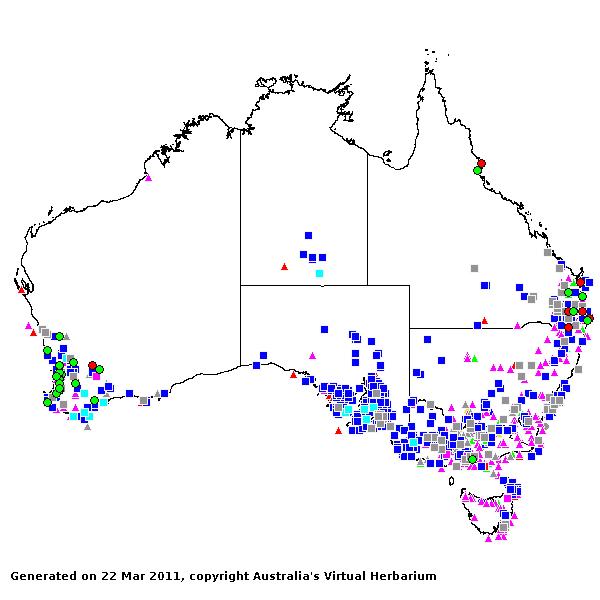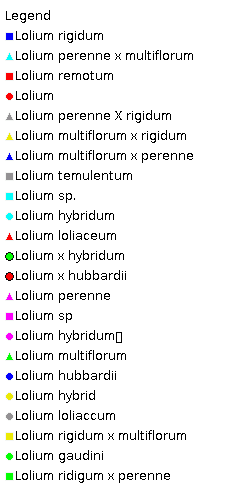Lolium* Sp. Pl. 83 (1753).
Derivation:. The Latin name for darnel, Lolium temulentum.
Taxonomic revisions, nomenclatural references:. P.M.Kloot, Austr. J. Bot. 31: 421–435 (1983).
Key references (keys and floras):. G.Bentham, Flora Australiensis 7: 666–667 (1878); C.A.Gardner, Flora of Western Australia 1 Gramineae 190–193 (1952); M.Lazarides, Flora of Central Australia 430 (1981); J.C.Tothill and J.B.Hacker, Grasses of Southern Queensland 300–301 (1983); B.K.Simon, Key to Australian Grasses 129 (1993); J.P.Jessop, Flora of South Australia 4: 1892–1896 (1986); S.W.L.Jacobs and K.L.McClay, Flora of New South Wales 4: 612–614 (1993); N.G.Walsh, Flora of Victoria 2: 403–476 (1994); D.I.Morris, Student's Flora of Tasmania 4B: 199–202 (1994); E.Edgar and H.E.Connor, Flora of New Zealand 5: 124–129 (2000); D.Sharp and B.K.Simon, AusGrass (2002); J.P.Jessop, Grasses of South Australia 131–139 (2006); S.W.L.Jacobs, R.D.B.Whalley & D.J.B.Wheeler, Grasses of New South Wales, 4th ed, 296–298 (2008); A.Wilson (ed.), Flora of Australia 44A: Poaceae 2: 284–290 (2009).
W.D.Clayton & S.A.Renvoize, Genera Graminum (1986), genus (109).
Naturalised. 7 species, from temperate Eurasia, north Africa. 5 species in Australia, WA, NT, SA, Qld, NSW, Vic, and Tas. Also Malesia and New Zealand.
Habit. Annual or perennial, rhizomatous or stoloniferous or tufted or decumbent. Leaf blades usually narrow. Ligule an unfringed membrane.
Inflorescence. Inflorescence a single spike (with partially embedded spikelets), a single raceme or spike.
Spikelets. Spikelets all partially embedded in rachis (edge on to axis), laterally compressed, more than 2 flowered, with 2 or more fertile florets, solitary, sessile; with naked rachilla extension. Fertile spikelets disarticulating above glumes.
Glumes. Glumes one per spikelet (except that the terminal spikelet has two), shorter than adjacent lemmas or long relative to adjacent lemmas, pointed or blunt, awnless, non-keeled. Upper glume (the only glume) 3–7 nerved (membranous).
Florets. Fertile florets 2–22. Lemmas less firm than glumes to decidedly firmer than glumes (membranous to papery, sometimes turgid or hardening in fruit), becoming indurated to not becoming indurated, entire at apex or incised, when entire pointed or blunt, muticous or awned, 5–7 nerved, glabrous. Awns when present, 1, from a sinus or dorsal, non-geniculate, hairless, much shorter than body of lemma. Palea relatively long (usually ciliate), apically notched, 2 nerved. Distal incomplete florets underdeveloped. Callus short. Lodicules 2. Stamens 3. Grain small or medium sized or large, longitudinally grooved, compressed dorsiventrally. Hilum long-linear. Embryo small.
Kranz Anatomy. C3.
2n = 14 and 28, 2 and 4 ploid, commonly adventive.
Habitat. Mesophytic. Species of open habitats.
Classification. Pooideae; Poeae.
Notes. All the species are more or less interfertile; consequently they intergrade morphologically and are very difficult to separate (Clayton and Renvoize, 1986).
Types Species. L. perenne L.
Biogeographic Element. Clifford & Simon 1981, Simon & Jacobs 1990: Naturalised.


